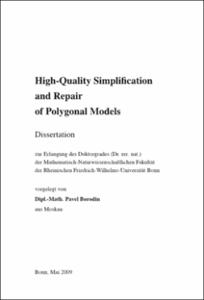High-Quality Simplification and Repair of Polygonal Models

High-Quality Simplification and Repair of Polygonal Models

| dc.contributor.advisor | Klein, Reinhard | |
| dc.contributor.author | Borodin, Pavel | |
| dc.date.accessioned | 2020-04-14T04:01:04Z | |
| dc.date.available | 2020-04-14T04:01:04Z | |
| dc.date.issued | 05.11.2009 | |
| dc.identifier.uri | https://hdl.handle.net/20.500.11811/4153 | |
| dc.description.abstract | Because of the rapid evolution of 3D acquisition and modelling methods, highly complex and detailed polygonal models with constantly increasing polygon count are used as three-dimensional geometric representations of objects in computer graphics and engineering applications. The fact that this particular representation is arguably the most widespread one is due to its simplicity, flexibility and rendering support by 3D graphics hardware. Polygonal models are used for rendering of objects in a broad range of disciplines like medical imaging, scientific visualization, computer aided design, film industry, etc. The handling of huge scenes composed of these high-resolution models rapidly approaches the computational capabilities of any graphics accelerator. In order to be able to cope with the complexity and to build level-of-detail representations, concentrated efforts were dedicated in the recent years to the development of new mesh simplification methods that produce high-quality approximations of complex models by reducing the number of polygons used in the surface while keeping the overall shape, volume and boundaries preserved as much as possible. Many well-established methods and applications require "well-behaved" models as input. Degenerate or incorectly oriented faces, T-joints, cracks and holes are just a few of the possible degenaracies that are often disallowed by various algorithms. Unfortunately, it is all too common to find polygonal models that contain, due to incorrect modelling or acquisition, such artefacts. Applications that may require "clean" models include finite element analysis, surface smoothing, model simplification, stereo lithography. Mesh repair is the task of removing artefacts from a polygonal model in order to produce an output model that is suitable for further processing by methods and applications that have certain quality requirements on their input. This thesis introduces a set of new algorithms that address several particular aspects of mesh repair and mesh simplification. One of the two mesh repair methods is dealing with the inconsistency of normal orientation, while another one, removes the inconsistency of vertex connectivity. Of the three mesh simplification approaches presented here, the first one attempts to simplify polygonal models with the highest possible quality, the second, applies the developed technique to out-of-core simplification, and the third, prevents self-intersections of the model surface that can occur during mesh simplification. | en |
| dc.language.iso | eng | |
| dc.rights | In Copyright | |
| dc.rights.uri | http://rightsstatements.org/vocab/InC/1.0/ | |
| dc.subject | Computergrafik | |
| dc.subject | 3D-Netze | |
| dc.subject | Polygonale Modelle | |
| dc.subject | Simplifizierung | |
| dc.subject | Orientierung von Normalen | |
| dc.subject | computer graphics | |
| dc.subject | 3D meshes | |
| dc.subject | polygonal models | |
| dc.subject | mesh simplification | |
| dc.subject | mesh repair | |
| dc.subject | gap closing | |
| dc.subject | normal orientation | |
| dc.subject | out-of-core simplification | |
| dc.subject.ddc | 004 Informatik | |
| dc.title | High-Quality Simplification and Repair of Polygonal Models | |
| dc.type | Dissertation oder Habilitation | |
| dc.publisher.name | Universitäts- und Landesbibliothek Bonn | |
| dc.publisher.location | Bonn | |
| dc.rights.accessRights | openAccess | |
| dc.identifier.urn | https://nbn-resolving.org/urn:nbn:de:hbz:5N-19384 | |
| ulbbn.pubtype | Erstveröffentlichung | |
| ulbbnediss.affiliation.name | Rheinische Friedrich-Wilhelms-Universität Bonn | |
| ulbbnediss.affiliation.location | Bonn | |
| ulbbnediss.thesis.level | Dissertation | |
| ulbbnediss.dissID | 1938 | |
| ulbbnediss.date.accepted | 24.08.2009 | |
| ulbbnediss.fakultaet | Mathematisch-Naturwissenschaftliche Fakultät | |
| dc.contributor.coReferee | Weber, Andreas |
Files in this item
This item appears in the following Collection(s)
-
E-Dissertationen (4162)




